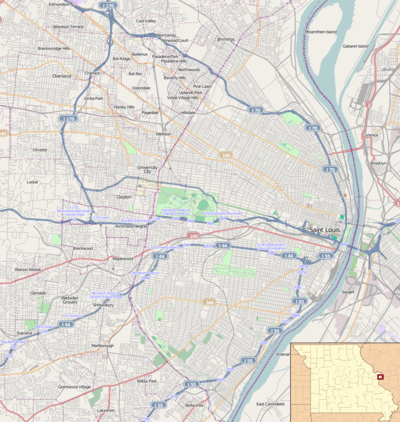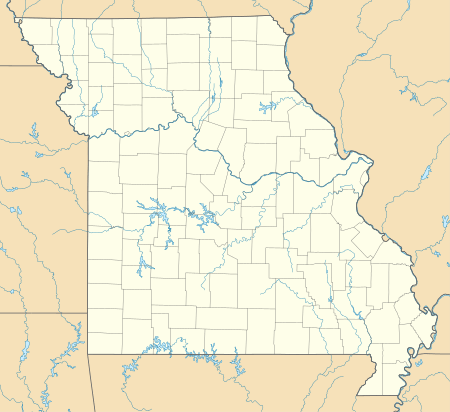Ely Walker Lofts
Ely Walker Lofts (originally known as the Ely and Walker Dry Goods Company Building) is a building located at 1520 Washington Avenue in St. Louis, Missouri. In 1857, David Davis Walker, a member of the Bush family, arrived in the city of St. Louis from Illinois. David Davis Walker was the great-grandfather of future president George H. W. Bush and first cousin of Supreme Court Justice and Independent U.S. Senator from Illinois David Davis, a pivotal figure in the disputed presidential election of 1876. In 1880, Walker founded the company Ely, Walker & Company along with Frank Ely, a company which became a leading dry goods wholesaler west of the Mississippi River until it was acquired by Burlington Industries after World War II.

Ely and Walker Dry Goods Company Building | |
| Location | 1520 Washington Avenue, St. Louis, Missouri |
|---|---|
| Coordinates | 38.632589°N 90.202239°W |
| Built | 1906-07 |
| Architect | Eames & Young |
| Part of | Washington Avenue Historic District (ID86003733) |
| Designated CP | February 27, 1987 |
It was designed by St. Louis architects Eames & Young. In 1906, construction on this warehouse began.[1] The building was completed in 1907 as a warehouse for shoes, Catholic school uniforms, and gun holsters.[2] Eames & Young was a St. Louis architecture firm active between 1885 and 1927 which was responsible designing several buildings on the National Register of Historic Places. William Eames, one of its founders and the uncle of architect Charles Eames, was president of the American Institute of Architects in from 1904 until 1905.[3]
It was built to be fireproof, with steel-frame and hollow tile floors, and with brick and terra cotta sheathing. Its main facades are north on Washington Avenue, with 15 bays, and south on St. Charles Street. Its east and west facades are also exposed and are similar to the Washington Avenue facade. It has a two-story base level "with vermiculated terra cotta 'quoins' which alternate with terra cotta quoins of smooth finish. At the upper stories, the piers are clad in brick with terra cotta accents. The terra cotta ornament includes a variety of Classical Revival motifs--broken pediments above the 4th floor windows, garlands at the 7th story and foliated ornament at the cornice. Dark gray terra cotta ornaments the spandrels at several stories. Especially noteworthy is the monumental entrance featuring ornamental terra cotta in a foliated cable design surmounted by an elaborate cartouche. There is a small, three-bay, one story section at the east end of the building clad in similar materials." About the space provided by this building, Ely and Walker was described, a few years later, as having the "'largest merchandise floors in America'".[4]
It is a contributing building in the Washington Avenue Historic District, which is listed in the National Register of Historic Places. The district comprises 55 commercial buildings constructed between 1899 and 1931 with over 75 percent of these buildings designed by prominent architects. The seven-story Ely Walker building is the second-largest of these 55 buildings and is known for its terracotta ornamentation.[4] The building is now used for residential apartments.[5] Many other Washington Avenue landmarks have also been converted to residential housing.[6]
Other Ely Walker buildings include the Ely and Walker Shirt Factory No. 5 in Kennett, Missouri, which added to the National Register of Historic Places in 2008, and buildings which were located in the Missouri cities of Illmo, Salem, Vandalia, Warrenton, and Paragould, Arkansas.[7]
References
- Nini Harris (2018). This Used to Be St. Louis. St. Louis, MO: Reedy Press, LLC. p. 30. 9781681061139.
- "Booming Before the Boom". stimag. 2007-08-31. Retrieved 2019-12-25.
- "Eames and Young, Architects (Partnership)". Retrieved 2020-01-01.
- James M. Denny (December 9, 1986). National Register of Historic Places Inventory Nomination: Washington Avenue Historic District (PDF) (Report). Historic Preservation Program, Dept. of Natural Resources, State of Missouri. Retrieved 2020-01-01. With photos, the 15th being a 1986 photo of the Ely Walker building (page 79 in PDF).
- Tim Bryant (2016-09-10). "What about that Ely Walker building?". Retrieved 2019-12-30.
- "Rich In Revitalized Landmarks, St. Louis Is On A Roll". Retrieved 2020-01-01.
- Federal Register, Volume 5, Issues 214-233. 1940. p. 4378.


